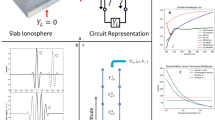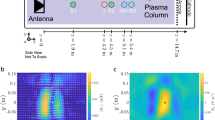Abstract
THE conductivity of the ionosphere can be expressed as a tensor containing three components—σ0, σ1 and σ2 representing, respectively, conductivity along the magnetic field (“longitudinal”), along an applied electric field itself perpendicular to the magnetic field (“transverse” or “Pedersen”1), and perpendicular to both the electric and magnetic fields (“Hall”2,3). A sample computation of Hall and Pedersen conductivities based on an electron density profile taken during auroral activity4 is shown in Fig. 1. For a given applied electric field independent of height the resultant current is obviously a function of height and can be computed from the geometry. It now seems that afternoon radio aurorae are basically reflexions from ion acoustic waves generated by a two-stream instability set up when electrons flow through the ions with a relative velocity some factor greater than the ion acoustic speed5–9. The auroral echoes are received only when the radial from the radar is perpendicular to the magnetic field, and most favourable circumstances occur when the electric current flows along this direction also.
This is a preview of subscription content, access via your institution
Access options
Subscribe to this journal
Receive 51 print issues and online access
$199.00 per year
only $3.90 per issue
Buy this article
- Purchase on Springer Link
- Instant access to full article PDF
Prices may be subject to local taxes which are calculated during checkout
Similar content being viewed by others
References
Pedersen, P. O., The Propagation of Radio Waves, Danmarks Naturvidenskabelige Samfund, A, No. 15a, Copenhagen (1927).
Baker, W. G., and Martyn, D. F., Phil. Trans. Roy. Soc., 246, 281 (1953).
Chapman, S., Nuovo Cimento Supplemento, 4, series X, 1385 (1956).
Baker, K. D., Pflster, W., and Ulwick, J. C., Space Res., 7, 665 (North Holland Publishing Co., Amsterdam, 1967).
Farley, jun, D. T., Phys. Rev. Lett., 10, 279 (1963).
Buneman, O., Phys. Rev. Lett., 10, 285 (1963).
Farley, jun, D. T., J. Geophys. Res., 68, 6083 (1963).
Bowles, K. L., Balsley, B. B., and Cohen, F., J. Geophys. Res., 68, 2485 (1963).
Leadabrand, R. L., Schlobohm, J. C., and Baron, M. J., J. Geophys. Res., 70, 4235 (1965).
Gadsden, M., Planet. Space Sci., 15, 893 (1967).
Leadabrand, R. L., Radio Sci., 69D, 959 (1965).
Unwin, R. S., and Knox, F. B., J. Atmos. Terrest. Phys., 30, 25 (1968).
Kim, J. S., and Wang, C. S., J. Atmos. Terrest. Phys., 29, 829 (1967).
Boström, R., J. Geophys. Res., 69, 4983 (1964).
Author information
Authors and Affiliations
Rights and permissions
About this article
Cite this article
NEWELL, R., ABEL, W. Indirect Experimental Evidence for the Existence of Hall and Pedersen Currents in the Auroral E Region. Nature 218, 454–456 (1968). https://doi.org/10.1038/218454a0
Received:
Published:
Issue Date:
DOI: https://doi.org/10.1038/218454a0
Comments
By submitting a comment you agree to abide by our Terms and Community Guidelines. If you find something abusive or that does not comply with our terms or guidelines please flag it as inappropriate.



